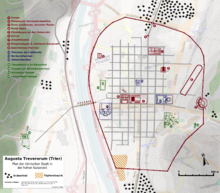
Augusta Treverorum (Latin for "City of Augustus in the Land of the Treveri") was a Roman city on the Moselle River, from which modern Trier emerged.
The date of the city's founding is placed between the construction of the first Roman bridge in Trier (18/17 BC) and the late reign of Augustus († 14 AD). In the Roman Empire, Trier formed the main town of the civitas of the Treverians, where several ten thousand people lived, and belonged to the province of Gallia Belgica. Roman Trier gained particular importance in late antiquity: between the late 3rd and late 4th centuries several rulers, including Constantine the Great, used the city as one of the western imperial residences, sponsoring monumental buildings such as the Trier Imperial Baths and the Basilica of Constantine. With a high five-digit population in 300, Augusta Treverorum, now sometimes called Treveris, was the largest city north of the Alps and thus had the status of a global city.
The Roman buildings, which have survived to the present day, were designated as UNESCO World Heritage Roman Monuments, Cathedral and Church of Our Lady in Trier in 1986.